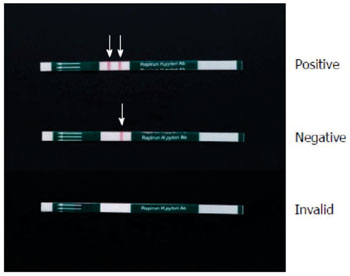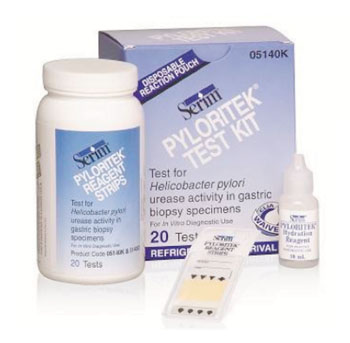Rapid Urine Test Evaluated for Helicobacter Pylori Infection
By LabMedica International staff writers
Posted on 26 Jun 2014
A rapid urine test based on enzyme-linked immunosorbent assay (ELISA) has been developed for the detection of anti-Helicobacter Pylori antibodies in urine.Posted on 26 Jun 2014
Several methods to diagnose H. pylori infection have been developed, among which the urea breath test (UBT) is currently regarded as the most accurate assay, but the UBT is still expensive and not widely available in many countries.
Scientists at the Ho Chi Minh City Medicine and Pharmacy University (Vietnam) working with Japanese colleagues, enrolled 200 patients undergoing upper gastrointestinal endoscopy from October 2012 to December 2012. Three biopsies were taken from each patient: two for histologic examination and one for the rapid urease test (RUT).
The biopsy for RUT was taken from the greater curvature of the corpus, about 2 cm above the atrophic border. This biopsy location has been reported to optimize the sensitivity of the PyloriTek RUT to detect H. pylori (Serim Research Co.; Elkhart, IN, USA). Urine samples were collected and were processed within one hour of collection for the detection of antibodies against H. pylori using the Rapirun Helicobacter pylori Antibody Stick (Otsuka Pharmaceutical Co., Ltd.; Tokyo, Japan). The test measures human immunoglobulin G (IgG) antibodies against H. pylori in urine using the principle of immunochromatography.
Of the 200 patients, 111 (55.5%) were diagnosed as being H. pylori positive. The sensitivity, specificity, and accuracy of the Rapirun Stick test were 84.7%, 89.9%, and 87.0%, respectively. There were 17 (8.5%) false-negative patients and 9 (4.5%) false-positive patients. Of the 24 patients with gastro-duodenal ulcer, 22 (91.7%) had H. pylori infection. However, 7 of 22 (31.8%) patients with reflux esophagitis also had the infection.
The authors demonstrated the usefulness of the Rapirun Stick test for the diagnosis of H. pylori infection in a Vietnamese population and the sensitivity, specificity, and accuracy of the Rapirun Stick test were high. In several patients, RUT and histologic examination produced false-negative or false-positive results, leading to the possible misdiagnosis of H. pylori infection. The study was published on May 7, 2014, in the World Journal of Gastroenterology.
Related Links:
Ho Chi Minh University of Medicine
Serim Research Co.
Otsuka Pharmaceutical Co.















